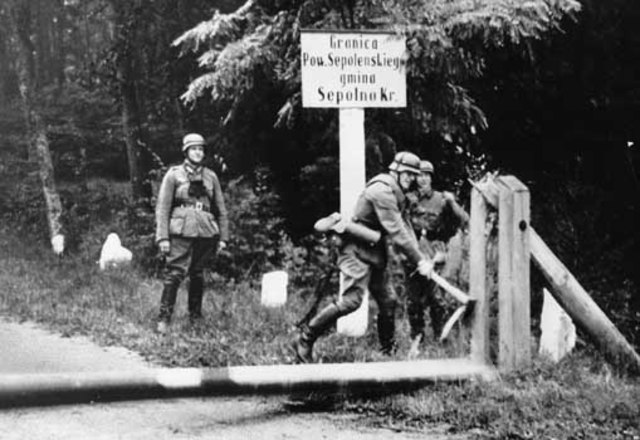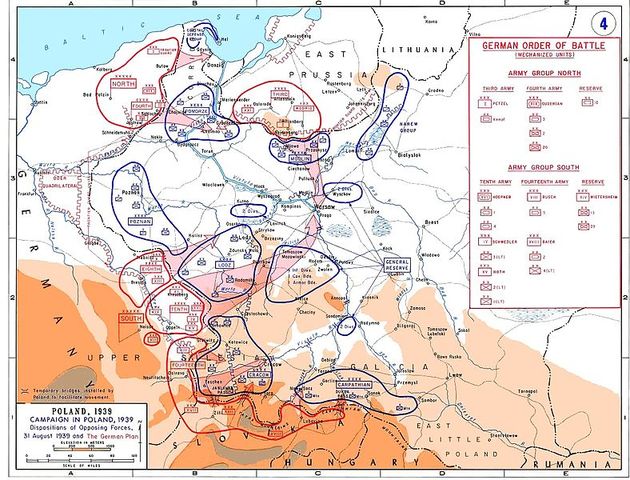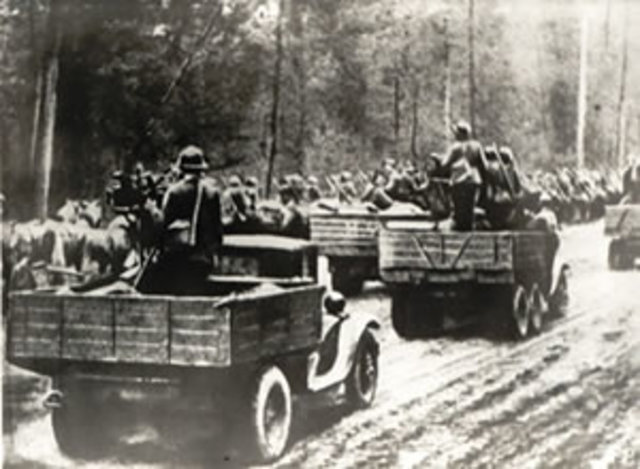|
|
Post by Haelicon on Oct 12, 2015 12:59:08 GMT
So, I want to teach you guys about World War II in Europe  . I bet you guys have already know about WWII, but maybe this thread could teach others who don't know about it yet, and maybe expand your knowledge about WWII in Europe. I'm helped by General William T. Sherman and Suvorov for this lecture. The outline is: First Chapter (1939-1940) 1. Fall Weiss (Invasion of Poland) {Page 1} 2. Soviet Invasion of Poland {Page 1} 3. Unternehmen Weserübung (Invasion of Denmark and Norway) {Page 2} 4. Fall Gelb and Fall Rot (Invasion of Low Countries and France) {Page 2} 5. Italian Invasion of France {Page 3} 6. Soviet annexation of Baltic States {Page 3} 7. The Winter War (Soviet Invasion of Finland) {Page 3} 8. Battle of Britain {Page 4} 9. The Atlantic War I 10. Greco-Italian War For the Second Chapter (1941-1943) and Third Chapter (1944-1945), I'm still compiling it. |
|
|
|
Post by General William T. Sherman on Oct 12, 2015 13:14:39 GMT
So, I want to teach you guys about World War II in Europe  . I bet you guys have already know about WWII, but maybe this thread could teach others who don't know about it yet, and maybe expand your knowledge about WWII in Europe. I'm helped by General William T. Sherman for this lecture. The outline is: First Chapter (1939-1940) 1. Fall Weiss (Invasion of Poland) 2. Soviet Invasion of Poland 3. Unternehmen Weserübung (Invasion of Denmark and Norway) 4. Fall Gelb (Invasion of Low Countries and France) 5. Italian Invasion of France 6. Soviet annexation of Baltic States 7. The Winter War (Soviet Invasion of Finland) 8. Battle of Britain 9. The Atlantic War 10. Greco-Italian War For the Second Chapter (1941-1943) and Third Chapter (1944-1945), I'm still compiling it. Fantastic! I felt that we would need this type of thread, and It's good that someone here is willing to provide some military history unlike I did with my Interbellum lecture (that will change with the Cold War, do not worry!). |
|
|
|
Post by Haelicon on Oct 12, 2015 15:42:47 GMT
1. Fall Weiss, or Case White Germany began its invasion in 1st September 1939 at 04:40, when Luftwaffe began the bombing of Polish city of Mokra, and in 04:45, the German dreadnought Schleswig-Holstein shelled Polish depot in Westerplatte. German troops began crossing Polish borders at 08:00. Germany strikes at Poland with the main assault in the west by Army Group South, secondary assault in the north by Army Group North, and tertiary assault in the south by German and Slovak troops. All three assault were to converge at Warsaw. Luftwaffe also obliterated Polish Air Force at day one, which resulted in full Air Superiority for the Luftwaffe.  German troops destroy border pole German troops destroy border poleGermany also employed new tactics, the Blitzkrieg. Blitzkrieg is a mobile assault doctrine, where coordinated tank assault, supported by aircraft and artillery pierced deep through the enemy lines, where infantry units followed to finish remaining enemy units and to widen the hole in the enemy lines. This contributed to the Germany success in the early stages of war. While Polish doctrine is outdated, where they still believed static defence and cavalry attacks. Even there are rumors about the Polish Cavalry brigade assault the German Panzers.  German Plan Map German Plan MapIn 3rd September, Germany already taken Vistula, Narew, and Warta river, and in 7th September, Germany had already reached the skirts of Warsaw. In 9th September, Guderian 3rd Army had already encircled Warsaw. The bulk of Polish Army were trapped as the result of this scissor assault. The Polish Army later split up to fragments, uncoordinated and retreating in the east of Vistula. Smigly, the Supreme Commander of Polish Army, later commenced a general retreat to the Southeast, or towards the Polish-Romanian border. Warsaw, which already heavily bombed in the first day of the war, was attacked in the same day (9th September), and later put on siege in 13 September because the initial German thrust stalled. The defenders in Wizna, where 700 Polish soldiers fight against the entire German 3rd Army, managed to hold and postpone the fall of Warsaw for 3 days. This allowed the Polish Government to move to London. Warsaw later capitulated after the capitulation of Poland. Polish defensive plan include the strategy to encircle the German spearhead. But this never happened, as Polish army failed to mobilizes. The panicked civilians also contributed to the Polish defeat, as mass retreat to the east lower the troop morale and made the logistics stuck. Also, while Polish government already knew about the impending German attack, they never mobilized as the Western Allies fear that it could provoke Germany. The British and France, which had already formed military alliance to hope that Germany wouldn't attack Poland, declares war to Germany in the 3rd September. Britain and France promises help for the Polish Goverment, with the form of invasion to Germany. Polish army retreated and waited for the help that never came. And all hope for Poland lost when the Soviet Union invades Poland in 17th September. We will be in depth for the Soviet Union Invasion of Poland in the next episode. |
|
|
|
Post by Suvorov on Oct 12, 2015 15:47:27 GMT
Excellent said! But the Western Allies forced the Poles not to mobilize their whole army otherwise they would provoke the Germans.
Also, the Polish were spread out over the whole enormous border, making their defences very weak. Instead, they should have focused on a more concentrated area.
Their resistance was, as you said, already doomed when the Polish air force was defeated.
Just one more thing: "Weiss"means in German "White"and not blue.
|
|
|
|
Post by General William T. Sherman on Oct 12, 2015 15:55:19 GMT
Great job!
|
|
|
|
Post by Haelicon on Oct 12, 2015 16:12:24 GMT
Excellent said! But the Western Allies forced the Poles not to mobilize their whole army otherwise they would provoke the Germans. Also, the Polish were spread out over the whole enormous border, making their defences very weak. Instead, they should have focused on a more concentrated area. Their resistance was, as you said, already doomed when the Polish air force was defeated. Just one more thing: "Weiss"means in German "White"and not blue. Edited, I must be confusing Weiss with Blau  , added the Poland mobilization problem too. Thank you for noticing. |
|
|
|
Post by Napoleon Bonaparte on Oct 12, 2015 16:44:44 GMT
So, I want to teach you guys about World War II in Europe  . I bet you guys have already know about WWII, but maybe this thread could teach others who don't know about it yet, and maybe expand your knowledge about WWII in Europe. I'm helped by General William T. Sherman and Suvorov for this lecture. The outline is: First Chapter (1939-1940) 1. Fall Weiss (Invasion of Poland) 2. Soviet Invasion of Poland 3. Unternehmen Weserübung (Invasion of Denmark and Norway) 4. Fall Gelb (Invasion of Low Countries and France) 5. Italian Invasion of France 6. Soviet annexation of Baltic States 7. The Winter War (Soviet Invasion of Finland) 8. Battle of Britain 9. The Atlantic War 10. Greco-Italian War For the Second Chapter (1941-1943) and Third Chapter (1944-1945), I'm still compiling it. brilliant, better get my ww2 history upgraded to the latest version (Rommel version  ) Well good for us, the more the merrier  |
|
|
|
Post by Napoleon Bonaparte on Oct 12, 2015 16:51:20 GMT
Excellent said! But the Western Allies forced the Poles not to mobilize their whole army otherwise they would provoke the Germans. Also, the Polish were spread out over the whole enormous border, making their defences very weak. Instead, they should have focused on a more concentrated area. Their resistance was, as you said, already doomed when the Polish air force was defeated. Just one more thing: "Weiss"means in German "White"and not blue. Yes, out of topic but Weiss is white and Blau is blue. Hope it is clear now  |
|
|
|
Post by Jean Lannes on Oct 12, 2015 21:14:17 GMT
Wasn't Fall Rot the invasion of France?
|
|
|
|
Post by Haelicon on Oct 13, 2015 15:18:37 GMT
2. Soviet Invasion of Poland. "It became apparent that all that was needed was an initial attack of the German Army and, after that, the attack of the Soviet [Army]; in order to leave nothing of [Poland,] this monstrous bastard of the Treaty of Versailles ..."- Vyacheslav MolotovSoviet Union invades Poland in 17th September. In the Secret Protocol of Molotov-Ribbentrop pact, Soviet should attack Poland soon after the attacks by Germany, but Soviet attacked 16 days later. This was because Stalin needed a truce with the Japanese, Soviet Union was in an undeclared war with the Japanese in Khalkin Gol (Nomonhan) before the World War II. When the cease fire was achieved in 16th September, Stalin ordered his forces to cross the Polish-Soviet border. The Soviet reason to invade Poland was because they needed to protect their own citizens in Eastern Poland, because the Polish Government had collapsed in the face of German invasion, and failed to provide security for their citizens.  Soviet forces on the move towards Grodno Soviet forces on the move towards Grodno
At the beginning of hostilities by Soviet forces, some several Polish cities including Dubno, Łuck and Włodzimierz Wołyński let the Soviet army come peacefully. And Polish general Juliusz Rómmel issued an unauthorized order to treat the Soviets as an ally. They believed that Soviet would help them against the Nazi Germany, but soon they realized that Soviets invaded them. Soviet entered the Eastern Poland with 450.000 to 1.000.000 troops, far outnumbered the Polish defenders. While Polish forces were decimated in the face of German attacks, the Polish Army is still a formidable force in 17 September 1939. Smigly commenced a general retreat towards the Polish-Romanian border and established a defence line in the Romanian Bridgehead. All this plan only works if Soviet Union remains neutral, and by 17 September, the entire plan were rendered useless. Smigly initially wants to resist and hold the Soviets, but dissuaded by Prime Minister Felicjan Sławoj Składkowski and President Ignacy Mościcki. Later Smigly ordered the Polish troops to fall back, only engaging the Soviets in self-defence. But the poor communication because of the Germans resulted many troops didn't recieve an orders, and some Polish and Soviet troops soon clashed all over the borders. Soviet forces often met German troops in the battlefield and cooperated with each others. German and Soviet troops also interact with each other with friendliness. The most remarkable event of this, is at Brest-Litovsk on 22 September. The German 19th Panzer Corps occupied the city but later turned it to the Soviet 29th Tank Brigade. The withdrawing Germans and the coming Soviet troops saluted each other. And in 28 September, Soviet forces had reached the agreed line in the Secret Protocol.  Soviet and German tank crew man Soviet and German tank crew man
The reaction from the Britain and France was muted, they don't want to be in a conflict with the Soviets. Later, in 6 October 1939, the Polish Army were effectively crushed and gone. Poland were to be divided between German and Soviet Union according the Secret Protocol in Molotov-Ribbentrop Pact. The west becomes part of the Germany and the east becomes part of the Soviet Union. Also a small part becomes part of Hungary and Slovakia. About 65,000 Polish troops were killed in the campaign, with 420,000 Polish troops captured by the Germans and 240,000 more by the Soviets (for a total of 660,000 prisoners). Up to 120,000 Polish troops escaped to neutral Romania, and another 20,000 to Latvia and Lithuania, with the majority eventually making their way to France or Britain. The Occupation of Poland is disastrous for the Poles. Soviets occupation in 1939-1941 resulted in the death of 150,000 and deportation of 320,000 of Poles. The German occupied area also executed the infamous Generalplan Ost, this resulted in 5.5 million to 5.7 million of Poles killed. Soviet Union later began its agenda in the Baltic states and Finland, while Germany turned its eyes to the West, simultaneously drawing plans for the North. Unternehmen Weserubung, a German victory in the North but with great loss for the Kriegsmarine, will be discussed in the next episode. |
|
|
|
Post by General William T. Sherman on Oct 13, 2015 19:04:29 GMT
Great job once again!
|
|
|
|
Post by Jean Lannes on Oct 13, 2015 21:03:49 GMT
Most people forget SU's involement in the Invasion of Poland and other events (Katyn as an example). Good job as always.
|
|
|
|
Post by Mountbatten on Oct 14, 2015 3:47:15 GMT
I didn't know that the SU wanted to bargain. They didn't care too much about Poland's well being hmmm?
|
|
|
|
Post by Jean Lannes on Oct 14, 2015 4:01:27 GMT
Of course did Russia hate Poland, they lost a war against them in the 1920s
|
|
|
|
Post by Haelicon on Oct 14, 2015 4:04:23 GMT
Wait.. Why did my chapter have {page 1}? I never change it  It's good though  |
|